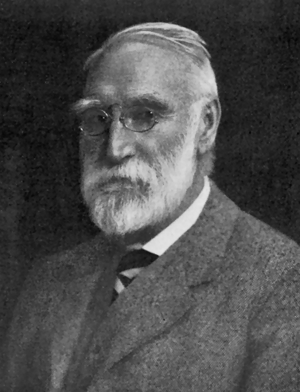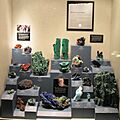James Douglas (businessman) facts for kids
Quick facts for kids
James Walter Douglas
|
|
|---|---|
 |
|
| Born | 4 November 1837 Quebec City, Quebec, Canada
|
| Died | 25 June 1918 (aged 80) Manhattan, New York, United States
|
| Nationality | Canadian |
| Education | University of Halle-Wittenberg University of Edinburgh Queen's University Université Laval |
| Spouse(s) | Naomi Douglas |
| Children | 6, including James Douglas Jr. |
| Parent(s) | James Douglas (father) (1800–1886) Elizabeth Ferguson (mother) |
| Relatives | Lewis Douglas (grandson) |
| Signature | |
James Walter Douglas (born November 4, 1837 – died June 25, 1918) was a smart Canadian engineer and businessman. He became very rich by finding new ways to mine copper, especially in places like Bisbee, Arizona and Sonora, Mexico. He made many important changes to how copper was taken out of the ground.
Contents
Life and Early Studies
James Walter Douglas was born in Quebec City, Quebec, Canada, on November 4, 1837. His father, James Douglas Sr., was a famous surgeon from Scotland. His mother, Elizabeth Ferguson, was also from Scotland.
James Douglas went to Queen's College in Kingston, Ontario, graduating in 1858. He continued his studies at the University of Edinburgh in Scotland. He studied both medicine and theology (the study of religion). For a few years, he was a chemistry professor at Morrin College in Quebec. In 1864, he became the manager of the Harvey Hill Copper Company in Quebec. Later, in 1875, he moved to the United States to work with copper in Phoenixville, Pennsylvania.
A Father's Influence
James Douglas's father, Dr. James Douglas, was a member of the Royal College of Surgeons of Edinburgh. He was known for being a very fast surgeon!
Dr. Douglas loved adventure and shared this with his son. He took young James on trips to Egypt and the Middle East. From these journeys, he brought back several mummies, selling them to museums. One mummy he sold was later found to be the body of Ramses I, a famous ancient Egyptian pharaoh.
Changing Careers: From Ministry to Mining
James Douglas first thought about becoming a minister in the Presbyterian Church in Canada. He studied at Queen's College and the University of Edinburgh. But by the end of his studies, he decided it wasn't for him. He felt his faith in organized religion wasn't strong enough to become an ordained minister.
In the 1860s, Douglas helped his father at the Beauport Asylum while studying medicine. He also worked as a librarian and later became the youngest president of the Literary and Historical Society of Quebec. There, he gave talks on many topics, from Egyptian hieroglyphics to mining.
His interest in mining and geology grew stronger than his interest in medicine. This led him to his third career. His father had lost money investing in the Harvey Hill copper mine. James Douglas wanted to help his family by making the mine profitable.
In 1869, Douglas and Dr. Thomas Sterry Hunt made an important discovery at Université Laval. They found a new way to get copper out of its ore (the rock it's found in). This was called the "Hunt and Douglas" process. Even though Douglas didn't have a formal chemistry degree, he was good enough to teach chemistry at Morrin College from 1871 to 1874. His evening lectures were very popular.
New Ways to Mine Copper
James Douglas and Thomas Sterry Hunt worked on many experiments to extract copper. Their "Hunt-Douglas" process was first patented in 1869. Douglas also invented other improvements for the mining industry. These included new ways to treat ores and better smelting furnaces. Smelting is a process that uses heat to separate metal from its ore.
In the early 1870s, he traveled to copper mines in Chile and North Carolina to share the Hunt & Douglas process. He also found a way to recover silver using his process.
Douglas believed in sharing new ideas and scientific discoveries. He hired smart young engineers and chemists to work at the mining companies he managed. This focus on research was one of the first of its kind in the mining industry.
Working with Phelps Dodge
Douglas's inventions caught the attention of companies in the United States. In 1875, he left teaching to work for the Chemical Copper Company in Phoenixville, Pennsylvania. In 1883, he moved to New York City to be closer to the financial world. He also worked as a mining consultant, visiting mines across the American West.
In 1880, a company called Phelps Dodge asked Douglas to check out their Detroit Copper Company in Morenci, AZ. While working, Douglas saw amazing copper samples from a mine in Bisbee, AZ called the Copper Queen mine. He visited the Copper Queen and another nearby claim called the Atlanta.
Douglas told Phelps Dodge to buy the Atlanta claim and invest in the Detroit Copper Co. He agreed to manage their operations in the West. He chose to take a 10% share in the property instead of a flat fee. This decision later made him very rich!
In 1885, Douglas helped Phelps Dodge buy the Copper Queen mine. This led to the creation of the Copper Queen Consolidated Mining Company. Douglas became its president and general manager. Under his leadership, the Copper Queen Mine became one of the world's top copper producers. Today, its old office building is the Bisbee Mining & Historical Museum.
Building Mining Towns and Railroads
In the late 1880s and early 1900s, with the success of the Copper Queen, Dr. Douglas helped Phelps Dodge buy more land and build other large copper mines. These included mines in Morenci, Arizona; Nacozari, Sonora, Mexico; and Globe, Arizona. He became president of these companies. He also hired talented young engineers, including his sons James and Walter, to help manage the growing business.
When the Copper Queen company built a new smelter east of Bisbee, the nearby town was named Douglas, Arizona, in his honor.
Douglas also wanted cheaper ways to transport materials and copper. He was unhappy with the prices from the existing railroads. So, he led the building of new railroad lines starting in 1888. These lines eventually connected the mines to major cities like El Paso, TX. In 1901, these lines became the El Paso and Southwestern Railroad.
In 1908, Phelps Dodge became a larger holding company, and Douglas was its first president. In 1917, it became the Phelps Dodge Corporation. Douglas became the CEO, and his son Walter became president. He helped turn the company into a very successful business.
James Douglas was always known as Dr. Douglas or Professor Douglas. His son, James S. Douglas Jr., known as "Rawhide Jimmy," also became a successful miner. His mansion in Jerome, Arizona, is now a public park called the Jerome State Historic Park. Walter Douglas followed his father's path, becoming CEO of Phelps Dodge. Dr. Douglas's grandson, Lewis Douglas, became a U.S. Congressman and later an Ambassador.
Giving Back: Books and Hospitals
James Douglas always cared about Canadian history. He wrote several books about it, including Old France in the New World.
He was also very generous. He helped Queen's University out of financial trouble by donating about a million dollars. He also started the first Canadian history program there in 1910. He funded many libraries, including the one at the Literary and Historical Society of Quebec. He also built and supported libraries in the mining towns run by Phelps Dodge.
Douglas was interested in how radiation could treat cancer. In 1911, he directed the Phelps Dodge research lab to find cheaper ways to produce radium. He teamed up with Dr. Howard Atwood Kelly, a doctor and giver, to supply radium in the U.S. They formed the National Radium Institute.
He also gave money to several medical causes. In 1912, he gave $100,000 to General Memorial Hospital for cancer research and X-ray equipment. In 1915, he helped set up a radium department to start radiation therapy in the United States.
The Douglas Hospital in Montreal, Quebec, is named after him and his father. His father was a pioneer in mental health treatment in Quebec. Douglas's donations helped keep the hospital running in its early years. In 1913, Douglas also donated nearly a million dollars worth of radium to Johns Hopkins University for medical research.
Awards and Recognition
James Douglas was a member of many scientific groups. He was president of the American Institute of Mining Engineers twice. Since 1922, the American Institute of Mining, Metallurgical, and Petroleum Engineers gives out the James Douglas Gold Medal in his honor every year. He wrote many articles about the copper industry and believed in sharing scientific information freely.
The Douglas Library at Queen's University, Kingston, Ontario, is named after him. So is Douglas Hall at McGill University. Dr. Douglas also supported a lecture series at the University of Arizona. In 1940, Phelps Dodge Corporation built the James Douglas Memorial Building for Mines and Metallurgy at the University of Arizona.
In 2018, the city of Nacozari de García, Mexico, named its Municipal Auditorium "James Douglas" to honor him 100 years after his death.
Images for kids
-
Malachite from the Copper Queen Mine, Bisbee, Arizona. Douglas saved many of the best mineral specimens for his collection. His family later donated them to the Smithsonian.



